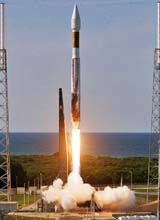
|

|

|

|

|
Cape Canaveral - May 14, 2003  An Atlas V rocket placed the Hellas-Sat satellite into orbit Tuesday evening, marking the 65th consecutive successful flight for Atlas, its builder Lockheed Martin and mission provider International Launch Services (ILS).
An Atlas V rocket placed the Hellas-Sat satellite into orbit Tuesday evening, marking the 65th consecutive successful flight for Atlas, its builder Lockheed Martin and mission provider International Launch Services (ILS). |
|
Meteorites Rained Down On Earth After Massive Asteroid Breakup Houston - May 13, 2003
Houston - May 13, 2003Using fossil meteorites and ancient limestone unearthed throughout southern Sweden, marine geologists at Rice University have discovered that a colossal collision in the asteroid belt some 500 million years ago led to intense meteorite strikes over the Earth's surface. Iridescent Glory Of Nearby Nebula Showcased On Astronomy Day  Washington - May 13, 2003
Washington - May 13, 2003In one of the largest and most detailed celestial images ever made, the coil-shaped Helix Nebula is being unveiled tomorrow in celebration of Astronomy Day (Saturday, May 10). |
Indian GEO Launcher and Associated Comsat Do Okay In Second Test Bangalore - May 13, 2003
Bangalore - May 13, 2003The second developmental test flight of India's Geosynchronous Satellite Launch Vehicle, GSLV, was successfully carried out this evening May 8, 2003 from Satish Dhawan Space Centre -- SHAR, Sriharikota, about 100 km north of Chennai, marking a major milestone in the Indian space programme. Communication Satellites Telling Us Where They Are  Paris (ESA) May 13, 2003
Paris (ESA) May 13, 2003Communication satellites will eventually be able to tell us where they are using new on board GNSS receivers that are being developed in a project funded by ESA. |
SLAC Experiment Identifies New Subatomic Particle Stanford - May 13, 2003
Stanford - May 13, 2003Physicist Antimo Palano, representing the BaBar experiment, presented the evidence for the identification of a new subatomic particle named Ds (2317) to a packed auditorium on April 28 at the Department of Energy's Stanford Linear Accelerator Center (SLAC). Scientists Returning To Field Of Eerie Thermal Spires  Seattle - May 13, 2003
Seattle - May 13, 2003The bizarre hydrothermal vent field discovered a little more than two years ago surprised scientists not only with vents that are the tallest ever seen -- the one that's 18 stories dwarfs most vents at other sites by at least 100 feet -- but also because the fluids forming these vents are heated by seawater reacting with million-year-old mantle rocks, not by young volcanism. |
Smells Like Teen Spirit Scottsdale - May 14, 2003
Scottsdale - May 14, 2003Before long, a private vehicle will make a successful suborbital flight. That flight will mark a passage from adolescence to adulthood for the space community, an achievement of independence from the stifling paternalism of stagnant government programs, writes John Carter McKnight. NASA As an Equity Partner  Washington - May 13, 2003
Washington - May 13, 2003NASA was embarking on a Space transportation system to replace the Space Shuttle before the Columbia disaster occurred. The current national Space transportation plan calls for the development of both near-term and long-term Space vehicle development programs. |
|
|
|
|
|
|
|
|
|
| The contents herein, unless otherwise known to be public domain, are Copyright 1995-2003 - SpaceDaily. AFP Wire Stories are copyright Agence France-Presse ESA Portal Reports are copyright European Space Agency. Additional copyrights may apply in whole or part to other bona fide parties. Advertising does not imply endorsement, agreement or approval of any opinions, statements or information provided by SpaceDaily on any web page published or hosted by SpaceDaily. Privacy Statement |